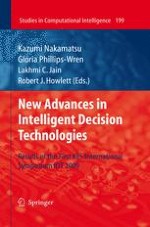IDT (Intelligent Decision Technologies) seeks an interchange of research on intelligent systems and intelligent technologies which enhance or improve decision making in industry, government and academia. The focus is interdisciplinary in nature, and includes research on all aspects of intelligent decision technologies, from fundamental development to the applied system.
It constitutes a great honor and pleasure for us to publish the works and new research results of scholars from the First KES International Symposium on Intelligent Decision Technologies (KES IDT’09), hosted and organized by University of Hyogo in conjunction with KES International (Himeji, Japan, April, 2009). The symposium was concerned with theory, design, development, implementation, testing and evaluation of intelligent decision systems. Its topics included intelligent agents, fuzzy logic, multi-agent systems, artificial neural networks, genetic algorithms, expert systems, intelligent decision making support systems, information retrieval systems, geographic information systems, and knowledge management systems. These technologies have the potential to support decision making in many areas of management, international business, finance, accounting, marketing, healthcare, military applications, production, networks, traffic management, crisis response, and human interfaces.
